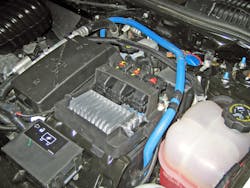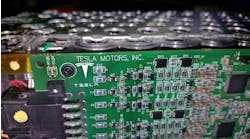The world around us is changing fast, and the automotive world is changing with it. The greater part of this dynamic is due to tougher government regulations regarding safety, emissions and fuel economy. Customer expectations play a role as well; whatever is considered new today becomes “old school” not long thereafter. In short, society is demanding more from its automobiles, and these escalating demands are creating a shift in the technologies that appear in our service bays.
Vehicle electrification is a technology trend that sputtered in its infancy but now is growing unabated. Most independent repair shops have experience with this as hybrid-electric vehicles (HEVs) have been around for over 20 years. While HEVs are commonplace, pure electrics (EVs) are now the primary growth area in the automotive industry. Certainly, there are common threads between these cars and their gasoline-powered cousins, but some profound differences exist. This article is written to discuss these differences and the way it will impact practices in our shops.
For decades, technicians have only had to deal with low voltages (less than 30 volts) when servicing most automotive electrical systems. These systems only required minimal precautions on the part of the technician, and their threat to personal safety was relatively low. However, the introduction of the modern HEV and EV has added a new dimension to our daily practice as they have electrical systems that operate at anywhere from 42 to 650 volts. If we plan on offering comprehensive service on these vehicles, we will have to adopt not only new procedures, but new attitudes as well.
Safety starts with attitude
Before we go any further, we need to make something abundantly clear. When servicing high-voltage (HV) automotive systems, be absolutely certain to follow the manufacturer’s recommended service procedures. These cars are a marvel of engineering, and no expense has been spared to make them intrinsically safe for the motoring public. However, a service technician could get into a place where “angels fear tread” and get hurt or killed if they aren’t careful.Being aware of the proper service procedures is one thing. It should be said, however, that safe and effective HEV service is going to require an attitude adjustment as well. We all get into a rush sometimes and bypass steps that we shouldn’t when working on cars. Maybe you’ve paid the price once or twice for taking this path. In the case of HV system service, the price is too high to justify skipping steps. Use the correct equipment and follow the recommended procedures at all times; no exceptions. We have a saying here in Alaska: “There are old pilots, and there are bold pilots, but there are no old bold pilots.” You can live to be an old technician if you decide that you won’t compromise on the safety issue.
Consequences If one is to take this safety stuff seriously, it is helpful to understand the impact that electricity has on the human body. What is most interesting here is that it is the current, not the voltage that actually does the damage. Keep in mind that voltage is electrical pressure; it is what pushes electrons through a conductor. Without sufficient voltage, very little current will flow. Conversely, the potential for higher current to flow becomes greater as voltage increases.
The human body is not a particularly good conductor, but it is a conductor nonetheless. If voltage is applied to human flesh, damage will be done in proportion to the amount of current that flows through it and for how long. While as little as 1 mA (milliamp or 1/1000th ampere) will cause a faint tingle, a mere 9 mA can cause a painful shock and a loss of muscle control. As current increases, the consequences also escalate:
50 mA can cause severe muscle contractions, and may stop breathing as well as preventing the victim from letting go
1 to 5 amperes will cause nerve damage and abnormal heart rhythm
10 amperes will cause severe burns, cardiac arrest, and probable death
Depending on the individual, death can occur when as little as 100 mA passes through the body for as little as 2 seconds. Based on this information, we need to do whatever is necessary to prevent electric current from flowing through our bodies. This will start with wearing the correct personal protective equipment or PPE.
Make yourself an insulator
When working on high-voltage automotive electrical systems, it is critical to examine everything you are wearing and ask yourself a basic question: Is this item helping to make me a conductor, or an insulator? Start your personal audit by removing all jewelry such as rings, watch bands and necklaces. You should also consider items that are less obvious. How about a metal belt buckle? Think carefully and remove any other clothing items that could compromise your safety in a high-voltage environment.
By default, safety glasses should be at the top of your list for high-voltage Personal Protective Equipment (PPE). It doesn’t matter what type of automotive work you are doing, you should be wearing your safety glasses. The complaints and arguments against them are well-known; I can’t see with these on, they don’t stay on the bridge of my nose, they make me look like a geek, etc. Just buy a pair of approved safety glasses that fit you and get over it! If necessary, get a prescription set if you don’t like the kind that goes over regular eye glasses. If you wear them long enough in the work environment, it will get to the point that you feel naked without them. Besides, there are plenty of stylish designs available that may even improve your image.
Footwear is another critical PPE item. Just like safety glasses, you should be wearing safety shoes whenever you are working in the automotive environment. Beyond protecting your toes, you need to examine your footwear for its electrical qualities. Remember, we are doing everything we can to make ourselves an insulator. Check to be sure that your shoes have rubber soles that will prevent you from becoming a path to ground.
HV glove care and feeding
Let’s talk about gloves. This may be the most important aspect of your personal protective equipment plan. Certified Class 0 linesman gloves must be worn whenever doing work on HV automotive electrical systems. While these may seem expensive at first glance, keep in mind that the correct gloves are specially constructed and certified by a lab to protect the wearer at up to 1000 volts AC. While this is more than enough protection for work on HEVs, it will be compromised if the glove gets damaged. To prevent damage, rubber linesman gloves should always be used with leather outers. They should also be carefully inspected before each use, including lightly inflating the glove to look for perforations. Some designs have made inspection easier by coloring the glove orange on the outside and blue on the inside. If the glove is damaged, discard it and replace it with a new set.
Electrical measurement
Another aspect of HV system service is the ability to make safe and accurate voltage measurements. Now is not the time to be using a multimeter of questionable pedigree; look for appropriate certifications and capabilities to be assured of your personal safety. For example, a meter should be approved by both the UL (Underwriters Laboratories) and CSA (Canadian Standards Association). The meter should also be certified to a minimum of CAT III at 1000 volts. An item that many technicians overlook is the quality and condition of the test leads they use with their multimeter. These should have ratings similar to your meter and be in good condition. Inspect them carefully before each use and replace any leads that are damaged.
When you are ready to make a measurement, start by confirming that the meter is working correctly. Take a DC volts measurement at the vehicle’s auxiliary (12 volt) battery first, and then continue your work once you know for sure that the meter is OK. Nothing like reading 0 volts at a HV voltage source because the meter has a blown fuse! This brings up another key point: NEVER assume that a high-voltage system is discharged. Always double-check the system with a functioning multimeter before concluding that it is safe to service.



